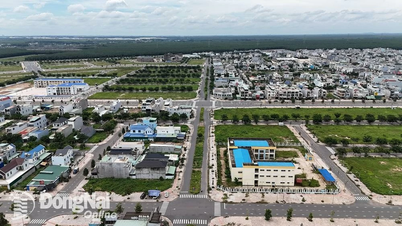Nghe An province currently has 8 ethnic boarding schools; 83 semi-boarding schools and 50 high schools with semi-boarding students, of which 16 high schools have students living and eating at the school.
Many problems arise
Since 2013, Huu Kiem Ethnic Boarding Secondary School (Ky Son District) has implemented a centralized boarding model. The school currently has 240 boarding students, mainly children of Thai and Kho Mu ethnic groups. Each month, a student is supported with 936,000 VND and 15 kg of rice according to the regulations in Decree No. 116/2016/ND-CP of the Government .
Luong Thi Ngoc Nhi (Thai ethnic group, 8C grade student) said: “My house is in Noong O village, Huu Lap commune, quite far from the school, so my friends and I have registered to stay in the school's dormitory. Here, we only focus on studying, without having to worry about shopping, cooking or rent. The dormitory operates under the management and guidance of teachers, so our parents are very secure. On weekends, we often return to the village together to visit our families.”
In Ky Son district, My Ly Secondary School for Ethnic Minorities has 393 students, of which 242 are boarding students. Boarding students are provided with meals and accommodation at the school.
Mr. Pham Huu Luan, Principal of the school, said that implementing the centralized boarding model helps students have better living conditions, and the school is also more convenient in managing them. The school organizes two sessions of teaching/day for students and assigns teachers to be on duty from 6am to 6am to look after and remind students to study, and clean the dormitory rooms and grounds, etc.
According to the assessment of the Departmentof Education and Training of Nghe An province, the system of boarding schools for ethnic minorities contributes to positively changing the quality of education in mountainous and particularly disadvantaged areas.
Implementing the boarding school model at the grassroots level helps reduce the rate of absenteeism and dropout, reduce inequality in access to educational opportunities, create better living and eating conditions for students in ethnic minority and mountainous areas, change the lifestyle and enhance life skills for students.
According to the assessment of the Department of Education and Training of Nghe An province, the system of boarding schools for ethnic minorities contributes to positively changing the quality of education in mountainous and particularly disadvantaged areas.
Although it has achieved many important results, recognized and highly appreciated, in 14 years of implementation, the model of ethnic boarding schools in Nghe An has revealed difficulties and shortcomings.
First of all, it is about infrastructure. In recent years, although all levels have paid attention to investment in construction, most of the facilities of ethnic boarding schools have not yet met the needs of students for food, accommodation and daily activities.
The system of classrooms, departmental rooms, and functional rooms is still lacking. A large number of students eat and live at school, and only go home once a month, so the issue of health care and safety for students is very important, while most schools do not have medical staff.
Teacher Pham Huu Luan said: The school has 242 boarding students, arranged in 10 rooms. Each room is about 15 square meters wide, the living and studying space of the students is quite cramped, especially in the hot season...
In addition, the management of boarding students in ethnic minority boarding schools is currently undertaken by teachers, and there are no specialized staff in charge of student management. However, the regime for these teachers is only entitled to an additional responsibility allowance equal to 0.3 of the basic salary, which is not commensurate with the efforts and responsibilities assigned. The fixed rate for cooking staff is still low, causing difficulties for schools in contracting staff...
Teacher Pham Huu Luan said: “Boarding students all eat and stay at school. The school organizes two sessions a day for students, but there is no money for teachers to teach the second session.”
According to the principal of Huu Kiem ethnic boarding secondary school, Nguyen Van Dang: “If compared to ethnic boarding secondary schools, the facilities and benefits for teachers of boarding schools are not equal. Boarding schools are fully staffed, have school health care, student management, and fully equipped facilities. The current teaching quota for teachers at boarding and semi-boarding secondary schools is 17 periods/week. For boarding schools, if teachers teach extra tutoring or training in the afternoon beyond the quota, they will be supported with extra teaching hours from the state budget. Meanwhile, teachers at boarding schools are not entitled to this policy.”
Worry when students have to rent accommodation outside
In Nghe An province, there are currently 25,113 students enjoying the regimes under Decree 116/ND-CP of the Government. Notably, many high schools have boarding students, but there is no centralized place to eat and stay, most students live far from school and have to rent rooms.
In Nghe An province, there are currently 25,113 students enjoying the regimes under Decree 116/ND-CP of the Government. Notably, many high schools have boarding students, but there is no centralized place to eat and stay, most students live far from school and have to rent rooms.
Tuong Duong 2 High School (Tuong Duong district) has 588 students/15 classes, of which ethnic minority students account for more than 80%. Many students live dozens of kilometers away from the school. Their homes are far away, the school does not have a dormitory, so about 50% of the school's students have to stay at local people's houses, living conditions are poor, many rooms are dilapidated, hot and do not ensure security and order...
During lunch break, we visited a boarding house about 500m from Tuong Duong 2 High School. Here, Lo Kieu Khanh (class 12A3) said: My house is in Tat village, Yen Thang commune, about 45km from the school. Every month I receive 1,170,000 VND for food and accommodation, but the rent for a boarding house is 800,000 VND, plus electricity and water, each month it costs a million VND. Sharing the same boarding house with Khanh, Luong Manh Cam (class 12A5) and three classmates from Yen Hop village, Yen Hoa commune rent a room together. Four people live in a room, with only one bed, because they have to save money to buy food every day...
Teacher Tran Dinh Manh, the school's principal, shared: "Although the school has tried very hard, students having to rent rooms has caused many problems, from self-study, health, to ensuring security and order. The students are in puberty, their thinking is still immature, they are not self-aware, there have even been cases of students getting pregnant unexpectedly... The fact that students have to rent rooms outside makes the school very worried."
Nguyen Trong Hoan, Chief of Office of the Department of Education and Training of Nghe An province, said: Circular No. 03/2023/TT-BGDDT stipulates that for ethnic minority boarding secondary schools, at least 45% of the students must be boarding. In reality, many schools with a boarding student ratio of less than 45% still have to organize management, care, and nurturing of students like ethnic minority boarding schools, but cadres, teachers, and employees do not enjoy preferential policies.
On the other hand, the criteria for classifying ethnic minority and mountainous areas according to the level of development have been raised, the number of communes and villages with special difficulties has decreased significantly, areas with especially difficult socio-economic conditions have changed in each period, so the ethnic boarding schools have also changed accordingly, lacking stability, making it difficult to organize and manage. It is worth mentioning that some communes have been recognized as new rural areas, but still lack sustainable livelihoods for the people, affecting policies for students.
In addition to the above limitations, the implementation of Resolution No. 17/2024/NQ-HDND of the People's Council of Nghe An province on Regulations on support policies for ethnic minority boarding schools and high schools piloting the ethnic minority boarding school model in ethnic minority and mountainous areas in Nghe An is also facing many difficulties.
 |
My Ly Secondary Boarding School for Ethnic Minorities, My Ly Commune, Ky Son District, Nghe An. |
At the workshop to resolve difficulties and obstacles in implementing this resolution held last February, representatives of schools and education and training departments assessed that this is an important policy, contributing to improving the quality of teaching and learning in ethnic minority and mountainous areas.
However, delegates also pointed out shortcomings in the implementation process and proposed solutions to help schools implement effectively, such as: Teaching equipment is lacking or has degraded, not meeting the requirements for teaching STEM, Foreign Languages, and Information Technology, especially in remote schools. There is a serious shortage of teachers, especially teachers of English and Information Technology.
In Ky Son district, there are currently only 20 English teachers/33 primary schools, some schools do not have English teachers, so they have to arrange secondary school teachers to teach primary school. Some schools have cultural teachers who also teach IT. STEM teachers and life skills teachers are mainly teachers with single-subject training... In Quy Chau district, although English teachers have just been added, teachers of this subject in some primary schools are having to teach 26-27 periods/week (exceeding 3-4 periods/week).
Discussing the solution, from the grassroots perspective, Mr. Pham Viet Phuc, Head of the Department of Education and Training of Ky Son district, along with many opinions from mountainous districts, suggested: It is necessary to soon have a decision to recognize ethnic boarding schools when all conditions are met. This is the basis to ensure the rights and policies for managers, teachers, staff and arrange the staffing for the schools to operate effectively.
In addition, relevant levels and sectors should also consider policies to ensure benefits for teachers in boarding schools in accordance with their workload and responsibilities. In addition, it is necessary to arrange additional staff for school health workers and student managers.
The representative of the Department of Education and Training of Nghe An province said: There should be a special regime to attract good teachers, encourage good teachers to work confidently in ethnic boarding schools in particular, ethnic minority and mountainous areas in general. In particular, the development of support policies for students, ethnic boarding schools, and schools with boarding students must be sustainable, not depending on the delimitation of ethnic minority and mountainous areas in each period.
Source: https://nhandan.vn/nang-cao-hieu-qua-mo-hinh-truong-pho-thong-dan-toc-ban-tru-post873015.html







![[Photo] Party and State leaders visit former President Tran Duc Luong](https://vphoto.vietnam.vn/thumb/1200x675/vietnam/resource/IMAGE/2025/5/24/960db9b19102400e8df68d5a6caadcf6)


















![[Photo] Party and State leaders visit former President Tran Duc Luong](https://vphoto.vietnam.vn/thumb/402x226/vietnam/resource/IMAGE/2025/5/24/960db9b19102400e8df68d5a6caadcf6)

![[Photo] The Central Party Executive Committee delegation visits former President Tran Duc Luong](https://vphoto.vietnam.vn/thumb/402x226/vietnam/resource/IMAGE/2025/5/24/32f67673454445aab0f1f2af331cb170)

![[Photo] Anh Hoang - Dinh Duc successfully defended the men's doubles championship of the National Table Tennis Championship of Nhan Dan Newspaper](https://vphoto.vietnam.vn/thumb/1200x675/vietnam/resource/IMAGE/2025/5/23/d6ab3bcac02c49928b38c729d795cac6)



































































Comment (0)